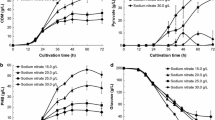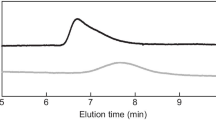Abstract
Production of (R)-3-hydroxybutyric acid [(R)-3-HB] by strain Halomonas sp. KM-1 under successive aeration conditions was investigated. The first aerobic condition allowed both cell growth and intracellular storage of poly-(R)-3-hydroxybutyric acid (PHB). The second microaerobic condition, achieved by reducing the culture agitation rate, lead to the degradation of PHB to (R)-3-HB. The amount of PHB stored in KM-1 cells after 48-h cultivation under aerobic conditions was 16.4 g/l. In contrast, after a shift from aerobic to microaerobic conditions and a further 18-h cultivation, PHB content in KM-1 cells decreased to 0.9 g/l. Numerous intracellular PHB-containing granules were observed in cells under aerobic conditions by electron microscopy. After the shift to microaerobic conditions, the number and size of granules were significantly reduced, in agreement with the degradation of prestored PHB. On the other hand, under microaerobic conditions, the concentration of (R)-3-HB in the medium reached a maximum of 15.2 g/l, indicating the production and extracellular secretion of (R)-3-HB as a result of PHB digestion. Notably, cell lysis was not observed during the successive aeration conditions as assessed by elution of genomic DNA to the culture supernatant, cell morphology observed by electron microscopy and counts of colony formation. In this simple system utilizing a change of aeration during cultivation of strain Halomonas sp. KM-1, we obtained one of the highest levels of microbiological production of (R)-3-HB reported to date.



Similar content being viewed by others
References
Chanprateep S (2010) Current trends in biodegradable polyhydroxyalkanoates. J Biosci Bioeng 110:621–632
Choi J, Lee SY (1999) Factors affecting the economics of polyhydroxyalkanoate production by bacterial fermentation. Appl Microbiol Biotechnol 51:13–21
Gao HJ, Wu Q, Chen GQ (2002) Enhanced production of D-(−)-3-hydroxybutyric acid by recombinant Escherichia coli. FEMS Microbiol Lett 213:59–65
Gerhard KH, Geoffrey SH (1984) The effect of micro-aerobic conditions on continuous ethanol production by Saccharomyces cerevisiae. Biotechnol Lett 6:681–686
Hirano M, Imai M, Abe K, Manabe E (1995) Influence of photosynthetic activity on fatty acid production by Spirulina platensis. J Mar Biotechnol 3:86–88
Hölscher T, Breuer U, Adrian L, Harms H, Maskow T (2010) Production of the chiral compound (R)-3-hydroxybutyrate by a genetically engineered methylotrophic bacterium. Appl Environ Microbiol 76:5585–5591
Ishizaki A, Tanaka K (1991) Production of poly-β-hydroxybutyric acid from carbon dioxide by Alcaligenes eutrophus ATCC 17697. J Ferment Bioeng 71:254–257
Kashiwaya Y, Takeshima T, Mori N, Nakashima K, Clarke K, Veech RL (2000) D-β-hydroxybutyrate protects neurons in models of Alzheimer’s and Parkinson’s disease. Proc Natl Acad Sci USA 97:5440–5444
Kawata Y, Aiba S (2010) Poly(3-hydroxybutyrate) production by isolated Halomonas sp. KM-1 using waste glycerol. Biosci Biotechnol Biochem 74:175–177
Kawata Y, Shi LH, Kawasaki K, Shigeri Y (2012a) Taxonomic characterization and metabolic analysis of the Halomonas sp. KM-1, a highly bioplastic poly(3-hydroxybutyrate)-producing bacterium. J Biosci Bioeng 113:456–460
Kawata Y, Kawasaki K, Shigeri Y (2012b) Draft genome sequence of Halomonas sp. strain KM-1, a moderately halophilic bacterium that produces the bioplastic poly(3-hydroxybutyrate). J Bacteriol 194:2738–2739
Lee SY, Lee Y (2003) Metabolic engineering of Escherichia coli for production of enantiomerically pure (R)-(−)-hydroxycarboxylic acids. Appl Environ Microbiol 69:3421–3426
Lee SY, Lee Y, Wang F (1999) Chiral compounds from bacterial polyesters: sugars to plastics to fine chemicals. Biotechnol Bioeng 65:363–368
Lemoigne M (1926) Produits de deshydratation et de polymerisation de l’acide β-oxybutyrique. Bull Soc Chim Biol 8:770–782
Liu Q, Ouyang SP, Chung A, Wu Q, Chen GQ (2007) Microbial production of R-3-hydroxybutyric acid by recombinant E. coli harboring genes of phbA, phbB, and tesB. Appl Microbiol Biotechnol 76:811–818
Massieu L, Haces ML, Montiel T, Hernández-Fonseca K (2003) Acetoacetate protects hippocampal neurons against glutamate-mediated neuronal damage during glycolysis inhibition. Neurosci 120:365–378
Monteil-Rivera F, Betancourt A, Van Tra H, Yezza A, Hawari J (2007) Use of headspace solid-phase microextraction for the quantification of poly(3-hydroxybutyrate) in microbial cells. J Chromatogr A 1154:34–41
Nakano K, Katsu R, Tada K, Matsumura M (2000) Production of highly concentrated xylitol by Candida magnoliae under a microaerobic condition maintained by simple fuzzy control. J Biosci Bioeng 89:372–376
Nath A, Bhat S, Devle J, Desai A (2005) Enhanced production of 3-hydroxybutyric acid (3-HB) by in vivo depolymerization of polyhydroxybutyric acid in 3-HB dehydrogenase mutants of Methylobaterium sp. ZP24. Ann Microbiol 55:107–111
Reddy CS, Ghai R, Rashmi A, Kalia VC (2003) Polyhydroxyalkanoates: an overview. Bioresour Technol 87(2):137–146
Seebach D, Albert KB, Breitschuh R, Job K (1992) Direct degradation of the biopolymer poly (R)-3-hydroxybutyric acid to (R)-3-hydroxybutanoic acid and its methyl ester. Org Synth 71:39–47
Shiraki M, Endo T, Saito T (2006) Fermentative production of (R)-(−)-3-hydroxybutyrate using 3-hydroxybutyrate dehydrogenase null mutant of Ralstonia eutropha and recombinant Escherichia coli. J Biosci Bioeng 102:529–534
Sundeep ND, Svihla CK, Thomas RH (1995) The effects of agitation and aeration on the production of gluconic acid by Aspergillus niger. Appl Biochem Biotechnol 51–52:347–354
Tokiwa Y, Ugwu CU (2007) Biotechnological production of (R)-3-hydroxybutyric acid monomer. J Biotechnol 132:264–272
Ugwu CU, Tokiwa Y, Aoyagi H, Uchiyama H, Tanaka H (2008) UV mutagenesis of Cupriavidus necator for extracellular production of (R)-3-hydroxybutyric acid. J Appl Microbiol 105:236–242
Ugwu CU, Tokiwa Y, Ichiba T (2011) Production of (R)-3-hydroxybutyric acid by fermentation and bioconversion processes with Azohydromonas lata. Bioresour Technol 102:6766–6768
Wells PA, Moyer AJ, Stubbs JJ, Herrick HT, May OE (1937) Gluconic acid production effect of pressure, air flow and agitation on gluconic acid production by submerged mold growths. Ind Eng Chem 29:653–656
Acknowledgments
This research was supported by a Grant-in-Aid for Scientific Research concerning waste management K22040 and K123009, a Grant-in-Aid for Scientific Research (C) (23580467), and an AIST research grant. We thank Shiho Kumata for technical assistance, Emiko Kobayashi (IBEC Center, AIST) for electron microscopy and Prof. Kenneth Takeda (CNRS, University of Strasbourg) for his careful reading of the manuscript.
Author information
Authors and Affiliations
Corresponding authors
Rights and permissions
About this article
Cite this article
Kawata, Y., Kawasaki, K. & Shigeri, Y. Efficient secreted production of (R)-3-hydroxybutyric acid from living Halomonas sp. KM-1 under successive aerobic and microaerobic conditions. Appl Microbiol Biotechnol 96, 913–920 (2012). https://doi.org/10.1007/s00253-012-4218-6
Received:
Revised:
Accepted:
Published:
Issue Date:
DOI: https://doi.org/10.1007/s00253-012-4218-6




